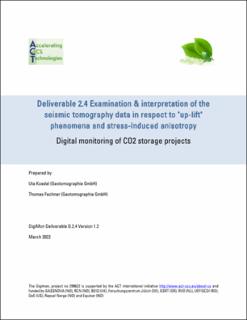| dc.description.abstract | In recent years, global concerns about greenhouse gas emissions have stimulated considerable interest in carbon capture and storage (CCS) as a climate change mitigation option that can be used to reduce man-made CO2 emissions. This is achieved by separating and capturing CO2 from emission sources, then injecting and storing it in the subsurface. However, CCS requires the secure retention of CO2 in geological formations over thousands of years. To achieve this, there are two distinct purposes for undertaking monitoring at CO2 storage sites: (1) to ensure conformance by tracking the pressure buildup and CO2 inside the storage complex, thereby helping to indicate the long term security of the site (‘integrity monitoring’) and (2) to ensure containment by triggering timely control measures to mitigate any unexpected leakage, helping to demonstrate the current security situation, especially in the area surrounding the storage complex (‘assurance monitoring’) (Bourne et al. 2014).
A significant issue for storage security is the geomechanical response of the reservoir. Concerns have been raised that geomechanical deformation induced by CO2 injection connected with pressure increase will create or reactivate fracture networks in the sealing caprocks, providing a pathway for CO2 leakage (Verdon et al. 2013). Several geochemical and geophysical (such as time-lapse seismic) techniques allow monitoring the regional distribution of CO2 in the storage complexes, seal integrity and the pressure evolution in response to the injection and therefore can be used to verify storage conformance and are valuable tools for integrity monitoring (IEA 2012).
The most significant environmental risk associated with CCS technology is gradual leakage through undetected faults, fractures, or wells, or the potential problems caused by leakages due to injection well failure or leakages up through an abandoned well. In addition, other issues include the influence of a CO2 plume, reservoir pressure changes, and geomechanical changes in the multilayered subsurface with minor and major faults as migration paths. There are injection-induced stress, strain, deformations, and potential microseismic events resulting from changes in reservoir pressure and temperature and unwanted unelastic mechanical changes that might reduce sequestration efficiency and cause concerns in the local community. | en_US |
